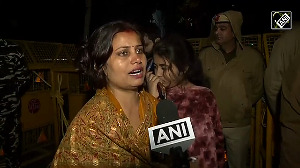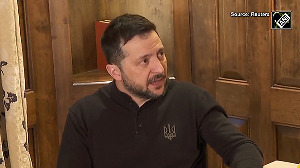'An influencer is expected to have upwards of 100,000 followers across various social media platforms of YouTube, Instagram, Facebook, Twitter etc,' points out brand strategist Ambi Parameswaran, founder, Brand-Building.com.
Illustration: Dominic Xavier/Rediff.com

At a panel discussion organised by a media company I was made to share the stage with a group of new age digital marketers.
It included the CEO of possibly India's biggest digital celebrity/influencer, Miss Malini, and a few more.
How do these digital mavens operate?
What is their secret sauce?
One of the panelists, a pretty successful blogger/youtuber, explained that she posts three videos every week.
And there is a particular day and time for the post to go live.
One of the posts is a fun post that is sheer 'time pass', the other is something that her followers will find useful.
She was from the beauty domain, so the post was often about something related to grooming which would be useful to her followers.
She keeps one more which is a sponsored post, that is often paid for by a brand.
Does she post 'any' message as long as she gets paid for it?
No! She is clear that her followers will get upset with her if she does not curate the content.
So she is very careful what she posts, even as a sponsored message.
She reaches out to companies when she sees a fit.
And only accepts invitations if she feels it would be of interest to her viewers.
Interesting, I thought.
Do celebrities who appear in television spots and charge a huge fee go through such a screening process, I wondered.
Intuitively the social media celebrity understood what the father of motivational research, psychology guru Ernest Dichter wrote about in 1966 in his Harvard Business Review article 'How word of mouth advertising works'.
Why do consumers talk to friends about a product or a service?
Dichter's research showed that there are three broad reasons.
The first is what he calls 'product involvement': You are so excited about a new product that you can't wait to speak about it to your friends.
The second is 'self involvement': You want to show off that you are the expert, you have inside information, you see yourself as an innovator.
The third is categorised as 'other involvement': Here you are genuinely concerned about the other person and want to share the information that will be of use to her/him.
I think in some ways the influencer who was on my panel was reflecting this age-old wisdom on why we spread ideas by 'word of mouth'.
If you are an influencer then you need to know more than your followers.
You need to project you have superior knowledge.
But you should also be aware that you have to help your followers benefit from your knowledge, without rubbing their nose in the dirt.
The global influencer market is expected to grow anywhere around $5 billion to $20 billion; we don't have reliable figures for India and I am not even sure if these numbers are traceable.
Given the fact that digital media is expected to grow to 20% of the total media spends of Rs 70,000 crore, we could assume that around 10 per cent of that may get deployed in various forms of influencer marketing games.
You may well ask me, 'Who is an influencer?'.
The definitions are difficult to come by.
By broad consensus an influencer is expected to have upwards of 100,000 followers across various social media platforms of YouTube, Instagram, Facebook, Twitter etc.
There is also the category of nano-influencers who have a smaller footprint but a more stronger following.
Clients are learning the game fast, ably assisted by social media marketing agencies.
Not only are they looking at the sheer number of followers but also the level of engagement.
The more the engagement, the more genuine the followership is.
The game is played better in the developed countries.
For instance, it was reported that Johnson & Johnson, when it unveiled its new natural range of baby products, enlisted the support of 100 influencers who blogged about baby care.
For the uninitiated, J&J owns and runs the world's biggest baby care Web site, BabyCenter.
But it went out of its 'own media" to reach out to influencers.
Influencer marketing is not restricted to just consumer products.
I was recently updated about a pharmaceutical brand that used the power of doctor influencers to spread the word about a new therapy group.
Obviously the brand was not mentioned in any of the influencer marketing efforts.
I remember car companies sharing their yet to be released television commercial to auto bloggers.
But that was in 2005.
Now the game has moved to a new level.
On the one hand, there was a complaint from the CMO of a luxury hotel saying that she gets 10 requests a day from 'influencer' asking for a free stay.
And we saw earlier how a powerful influencer picks and chooses who to promote on her channel.
So if you are looking at using the power of influencers don't just look at the numbers.
Also look at the quality of the numbers and the 'purpose' being served by the influencer to his or her followers.
Remember, the words of the father of motivation research.












 © 2025
© 2025